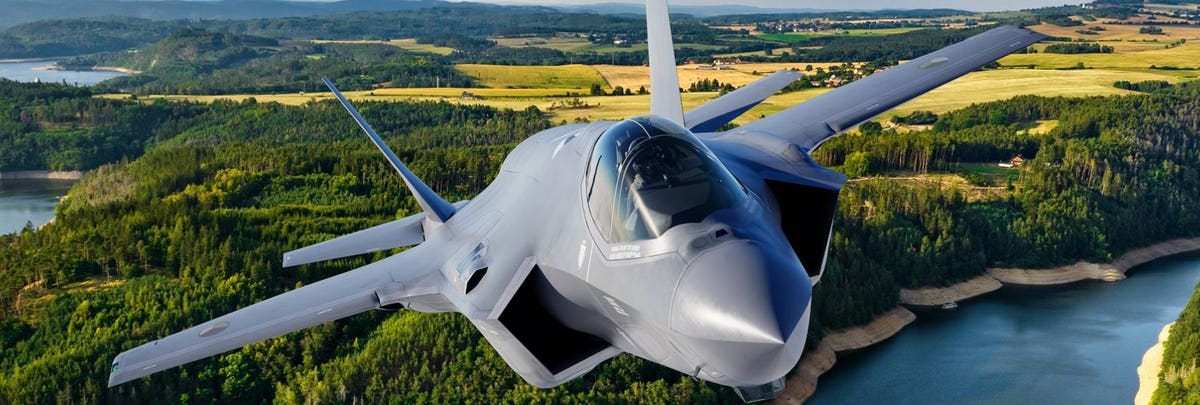The Czech Republic’s defense ministry confirmed today that the country’s government approved the purchase of Joint Strike Fighters but it looks like they won’t get the first one until 2030.
A statement from the Czech Republic Ministry of Defence spelling out the basic terms of the buy notes that “The first aircraft should arrive in the Czech Republic at the beginning of the next decade…”
The balance of the 24 F-35As should arrive over five years with the Army of the Czech Republic expecting “to achieve full operational capabilities in 2035,” according to the statement.
The timeline is a couple years later than earlier discussions of the Czech acquisition posited. Initial deliveries in 2028 had been muted but as I previously wrote, Lockheed Martin’s
LMT
The price tag for the aircraft, related equipment, training, ammunition and life cycle assurance by 2034 “amounts to just under five billion US dollars and will be phased in between 2024 and 2034,” according to the Ministry of Defence. When the U.S. State Department previously cleared the deal in June, it was estimated to be worth up to $5.6 billion.
The Czechs will reportedly spend another $1.5 billion on other associated base and infrastructure/equipment upgrades, a project it will have to get rolling now even if deliveries are a couple years later than anticipated.
The country’s defense ministry will also apparently have to renegotiate its lease of 14 Saab Gripen C/D fighters which the F-35s are slated to replace. Set to expire in 2027, extension of the lease was in discussion as far back as February according to a Reuters report. Presumably, the existing Gripen C/Ds will have to serve until some time around 2035 though a new lease could see the Czechs get newer Gripen Es.
Ironically, the Czech government selected the F-35 last year in preference to the Gripen E and Lockheed’s F-16V. Like other European governments (Switzerland, Poland, Finland), the Czech government sought to justify the perceived high cost of the F-35 purchase.
Defense Minister Jana Černochová, emphasized that the buy would amount to less than seven and a half percent of the country’s planned defense spending. “Thanks to this, I can guarantee that other modernization projects of the Army of the Czech Republic, especially the modernization of the heavy mechanized brigade, are not threatened by this project in any way.”
Černochová added that the Czech defense industry will get significant offset work from the deal. “In less than a year, we have prepared 14 industrial cooperation projects for Czech companies, including the possibility of joining the global supply chain for F-35 aircraft. We agreed to continue searching for opportunities in the future in promising areas such as space technologies, cybernetics, artificial intelligence. I consider this a great success.”
In its statement on the Czech government’s approval of the purchase, Lockheed emphasized that, “Our partnership with Czech industry will deliver benefits in research and development, manufacturing and sustainment.”
Lockheed obviously considers the sale a success, but it will have to press to deliver Czech jets, even by 2030. American demand for the F-35 has waned with recent budget deliberations and the canceled (for the moment) development of an alternative engine.
But recently reported delays in the pending Block 4 upgrade for the airplane which may not begin until around 2025, could push Lockheed up against its self-declared production rate of 156 F-35s per year or force it to exceed that pace to meet the Czech Republic’s order and other customer orders.
A schedule slip in the integration of Lockheed Martin software with TR-3 hardware (TR-3 provides the computing backbone to enable a suite of new capabilities for Block 4) caused the company to revise its delivery numbers this year down from between 147 and 153 stealth fighters to somewhere in the 100-120 range.
What that means for customers like the Czech Republic which expect Block 4 F-35s is tough to gauge at this point. Lockheed Martin has not addressed the capacity implications of the new buy, saying only that, “The F-35’s growing presence across Europe is a powerful example of alliance-based deterrence and is setting the foundation for NATO and allied nation’s next generation air power capability.”
I plan to follow-up with the company but nontheless, it’s clear that with the Czechs officially adding another 24 Lightning IIs to the production tally, Lockheed will need to resolve its Block 4 hiccups quickly and crank up the assembly line – even if it has two more years than expected.
Read the full article here





